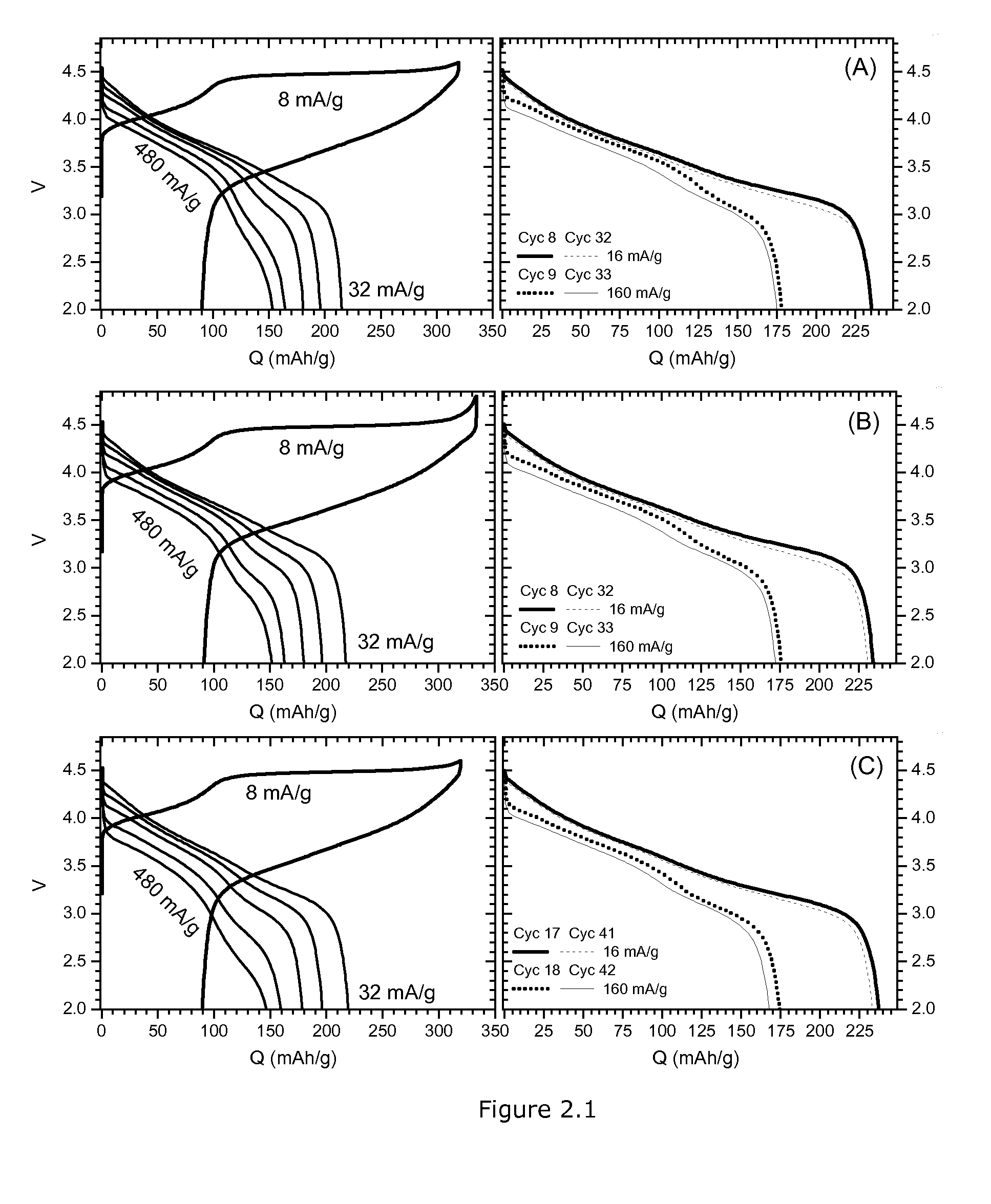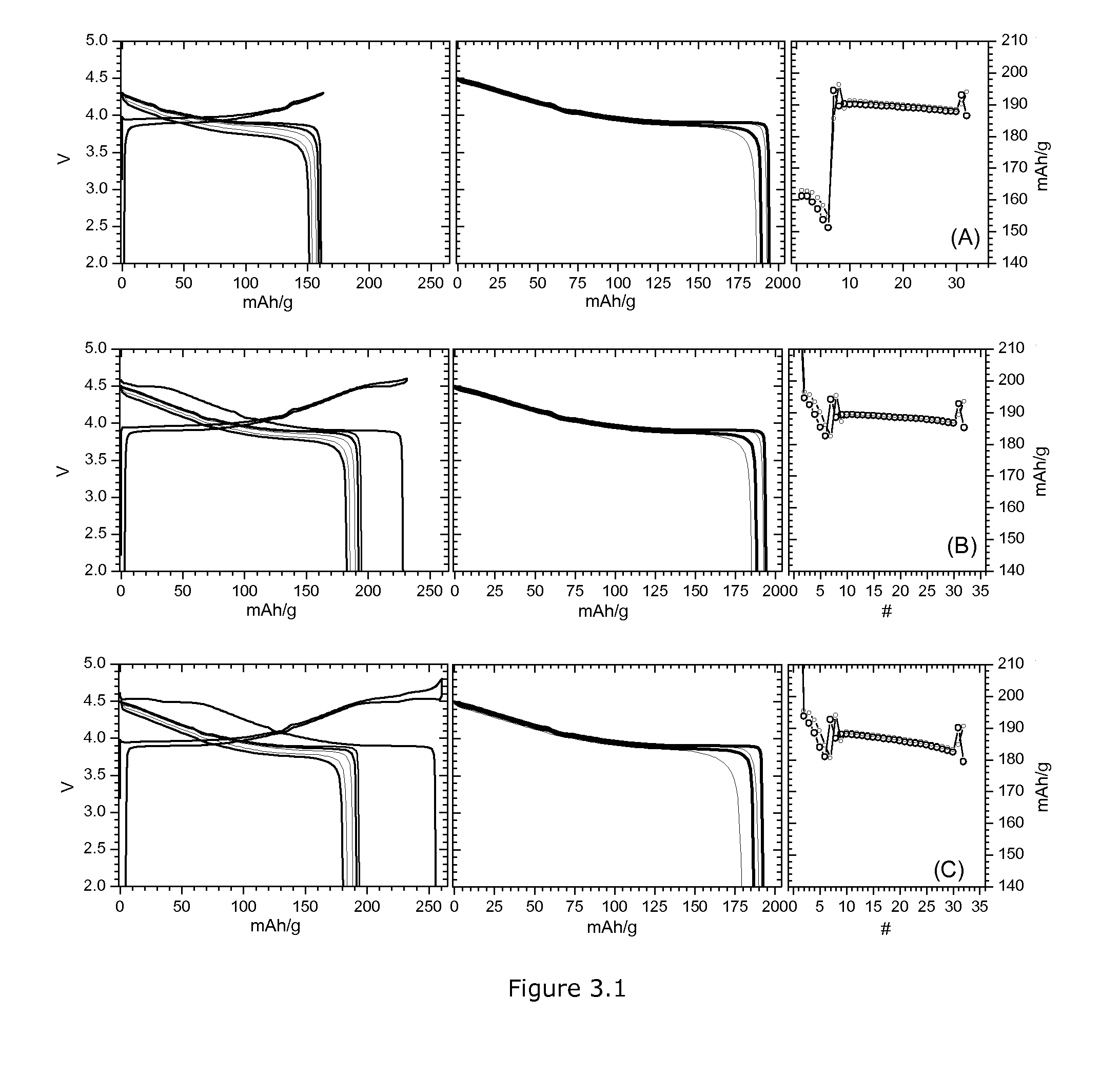Low Porosity Electrodes for Rechargeable Batteries
- Summary
- Abstract
- Description
- Claims
- Application Information
AI Technical Summary
Benefits of technology
Problems solved by technology
Method used
Image
Examples
example 1
Importance of Cobalt Doping of HLM
[0070]A major problem to cycle a mixture of large particles LCO and smaller particles HLM is the high voltage which is required during first charge of HLM. A typical value is 4.8V, but with each 10 mV that this voltage can be lowered the undesired side effects—e.g. the high voltage electrolyte decomposition—will become less severe. The current example shows that the voltage of the HLM can be lowered. Increasing the Co doping level causes a desired decrease of the charge voltage. Otherwise, too much Co doping is not desired because it reduces the reversible capacity.
[0071]3 MOOH precursors are prepared by precipitating a M-NO3 solution with a NaOH solution in the presence of ammonia. The cobalt content of the solutions is varied from 0 to 8.3 to 16.7 wt %. Table 1.1 lists the ICP analysis of the 3 precursors. The composition is very near to the targeted value. Of each precursor 3 samples with different Li:M ratio are prepared. Each precursor is mixed...
example 2
Activation of Cobalt Doped HLM
[0076]A mixed transition metal hydroxide is obtained by conventional precipitation (metal sulfate with NaOH in the presence of ammonia). The metal composition is M=Ni0.22Mn0.66Co0.11. The average particle size (D50 of the PSD) is about 8 μm.
[0077]The precursor is relatively dense (tap density=1.36 g / cm3). A final lithium metal oxide (HLM type) is prepared by mixing with Li2CO3(Li:M=1.57, corresponding to 50% of the Ni being 2-valent and 50% being 3-valent, assuming all Co is 3 valent and all Mn tetravalent). A high sintering temperature of 1000° C. is applied resulting in relative dense particles with relatively small surface area (0.65 m2 / g). SEM shows that primary crystallites are ranging from about 0.2 to 0.5 μm in size. Typical particles have sizes of about 5-10 μm.
[0078]Such a morphology is not preferred for obtaining a high electrochemical performance for HLM. Good performance is achieved after much softer sintering resulting in significant smalle...
example 3
Voltage Compatibility of LCO and HLM
[0089]HLM type materials are considered to require special formation cycles. A typical formation schedule is an activation either at 4.8V for one or more cycles. 4.8V is a very high voltage; when HLM is mixed with other cathode materials a 4.8V cycle can damage other cathode components. Alternatively it is often recommended to gradually increase the voltage during several formation cycles. Implementing such complex special formation at mass production requires severe investment and makes the application of HLM difficult in real cells. Example 2 showed that for HLM containing cobalt a single activation cycle at 4.6V is sufficient. Cycling HLM at 4.5V gives a high capacity. (At 4.5V the capacity is only about 5% less than 4.6V capacity.) Example 3 will show that these formation conditions of Example 2 are compatible with the “high voltage LiCoO2” discussed before. This is an important requirement if HLM and LCO cathode materials are used together. E...
PUM
 Login to View More
Login to View More Abstract
Description
Claims
Application Information
 Login to View More
Login to View More - Generate Ideas
- Intellectual Property
- Life Sciences
- Materials
- Tech Scout
- Unparalleled Data Quality
- Higher Quality Content
- 60% Fewer Hallucinations
Browse by: Latest US Patents, China's latest patents, Technical Efficacy Thesaurus, Application Domain, Technology Topic, Popular Technical Reports.
© 2025 PatSnap. All rights reserved.Legal|Privacy policy|Modern Slavery Act Transparency Statement|Sitemap|About US| Contact US: help@patsnap.com



